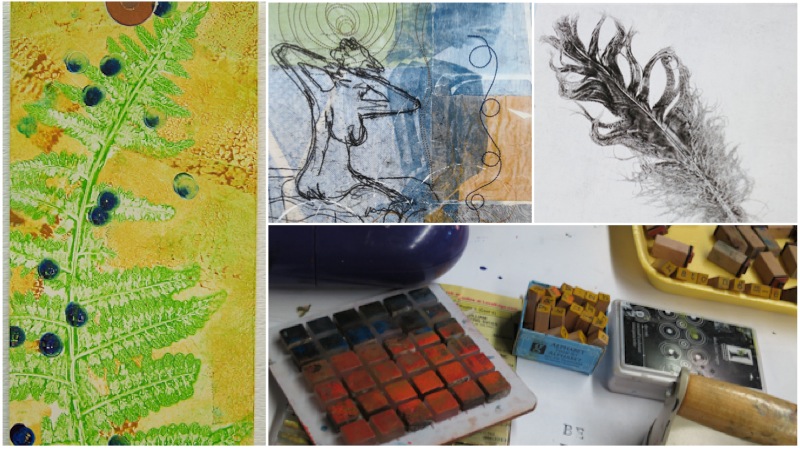Are you an impromptu printmaker? What types of printmaking processes lend itself to spontaneous printmaking?
With traditional printmaking there is planning the image, reversing the images, creating the plate or matrix, preparing the paper, working up the inks, set the press, organizing the blankets, setting up the drying racks and you have not even started to print yet.

I would describe myself as an impromptu printmaker. All that planning and preparation is just not my style. As I was walking around the lake today, I was listing the printmaking processes that are a little more spontaneous:
- Relief stamping can be quick
- Stencil with found object is fast
- Monotype printing without a press
- Some types screen printing (thermofax) can be quick
- Trace monoprint is probably the fastest
How about you? Do you like careful planning or do like to make marks quickly, spontaneously or as inspired?
Check out the current printmaking workshops that I am offering.
Happy Printing
For me, the only planning I’ve been doing is trying to get the right amount of water to paint ratio on the gelatin plate. I use acrylic paints mixed with GAC 900 fabric medium on various types of fabric. I like there to be a certain amount of “graininess” on my printed fabrics. And sometimes, I want a lot of water on the plate so that only some of the paint gets lifted and a lot of the white space of the fabric is randomly left alone and it leaves the fabric with a very spotty, soft print. But in terms of patterns and other preps, it’s all impromptu.
Found objects are a great source of inspiration for me. They make me imagine little stories and I love to play and invent sceneries using the same masks but different compositions and colors. It’s an impromptu process. I do not plan in advance. What I find around is the first step.
Will someone please explain what a “trace monoprint” is?… and how you would achieve it? Thank you!
As described here, trace monoprinting or trace monotypes are… : http://www.akuainks.com/trace-monotype
“Trace Monotype (also known as transfer drawing) is a direct-drawing printmaking technique. After inking a plate, paper is placed on top of the inky surface. Using a pen, stick or any other stylus, the image is drawn on the back of the paper. The pressure of the drawing tool picks up a line of ink on the paper as the pen bears down. When the paper is peeled off the plate, the lines appear on the paper. Usually a second print is pulled by printing the remaining ink on the plate. The second print yields a negative impression of the first print.”
I print all the time with leaves. I collect a bunch from around my yard then either use acrylic paint and brush on with a sponge brush, or use Clorox bleach pen and again brush it on the the leaves and print on my dyed fabrics!
I Love the Gelli Plate. I use acrylic paints, ink and sometimes a lot of water. I love to improvise. The use of all kinds of household materials is what makes this technique so much fun! It is also nice that you can make several prints in one time. Various printing positive and negative. I’m just an amateur but sometimes I feel a little bit of an artist LOL.
You are an artist! And you’re having fun. The Best!
I’m definitely a spontaneous artist, although, as I grow older I do find myself enjoying some processes that require quite a bit of planning and detail work, something I wouldn’t have had the patience to do before. I often spend hours on the computer now just researching tips, techniques, styles, and on and on and on…..! I play for hours with my images in photoshop now. And shibori dyeing has taken quite a bit of prep work before you get to the dyeing. But what I love the most is impromptu play! Lately that’s taking the form of sunprinting and nature printing on fabric for my fiber art. This evening I did a quick stencil with a found object that was fun. Some monoprinting is in the cards for the near future.
Pingback: What your kids and dogs already know